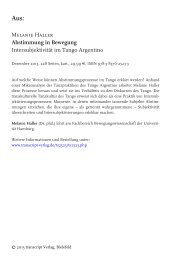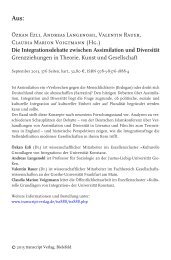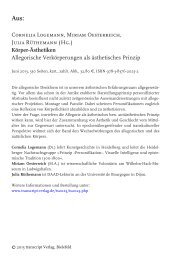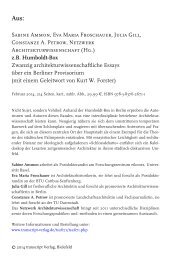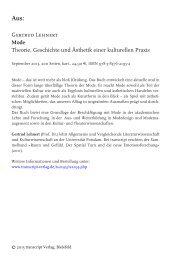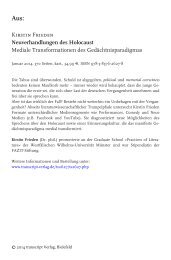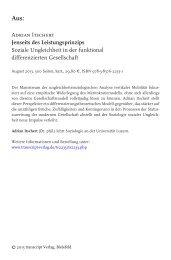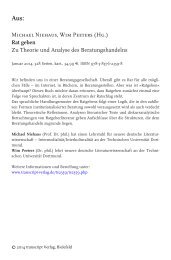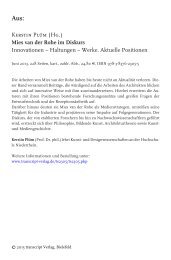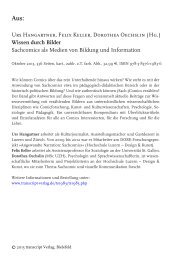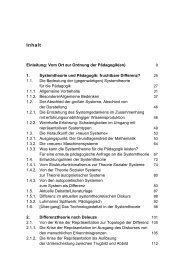Rainer Geissler, Horst Pöttker (eds.) Media ... - transcript Verlag
Rainer Geissler, Horst Pöttker (eds.) Media ... - transcript Verlag
Rainer Geissler, Horst Pöttker (eds.) Media ... - transcript Verlag
Create successful ePaper yourself
Turn your PDF publications into a flip-book with our unique Google optimized e-Paper software.
From:<br />
<strong>Rainer</strong> <strong>Geissler</strong>, <strong>Horst</strong> <strong>Pöttker</strong> (<strong>eds</strong>.)<br />
<strong>Media</strong> – Migration – Integration<br />
European and North American Perspectives<br />
January 2009, 250 p., 29,80 €, ISBN 978-3-8376-1032-1<br />
Following economists and scientists, politicians of various European countries have<br />
realized that a modern society with a declining birthrate is in need of immigrants.<br />
What can journalists contribute, in order to enable migrants to feel at home in their<br />
receiving country? What can be missed and ruined by journalists and media with regard<br />
to the integration of ethnic minorities?<br />
Scholars from Austria, Canada, France, Germany, Russia, Switzerland, The Netherlands,<br />
and the U.S. present their findings on the matter of media integration of migrants.<br />
Can European media learn from experiences in the classic countries of immigration<br />
in North America?<br />
Contributors are, among others, Heinz Bonfadelli, Augie Fleras and Kenneth Starck.<br />
<strong>Rainer</strong> Geißler (Dr. phil.) is Professor of Sociology at the University of Siegen.<br />
<strong>Horst</strong> <strong>Pöttker</strong> (Dr. phil.) is Professor of Journalism at the University of Dortmund.<br />
For further information:<br />
www.<strong>transcript</strong>-verlag.de/ts1032/ts1032.php<br />
© 2009 <strong>transcript</strong> <strong>Verlag</strong>, Bielefeld, Germany
Content<br />
<strong>Rainer</strong> Geißler/<strong>Horst</strong> <strong>Pöttker</strong><br />
Preface............................................................................................................................7<br />
<strong>Horst</strong> <strong>Pöttker</strong><br />
Successful Integration? <strong>Media</strong> and Polish Migration in the<br />
German Empire at the Turn of the 20th Century.............................................9<br />
<strong>Rainer</strong> Geißler/Sonja Weber-Menges<br />
<strong>Media</strong> Reception and Ideas on <strong>Media</strong> Integration among<br />
Turkish, Italian and Russo-German Migrants in Germany........................27<br />
Heinz Bonfadelli<br />
<strong>Media</strong> Use by Ethnic Minority Youth in Switzerland ..................................45<br />
Petra Herczeg<br />
Migrants and Ethnic Minorities in Austria:<br />
Assimilation, Integration and the <strong>Media</strong>..........................................................71<br />
Leen d’Haenens<br />
Whither Cultural Diversity on the Dutch TV Screen? ..................................97<br />
Souley Hassane<br />
Mainstream <strong>Media</strong> vs. Ethnic Minority <strong>Media</strong>: Integration in Crisis...117<br />
Augie Fleras<br />
Ethnic and Aboriginal <strong>Media</strong> in Canada: Crossing Borders,<br />
Constructing Buffers, Creating Bonds, Building Bridges.........................143<br />
Kenneth Starck<br />
Perpetuating Prejudice: <strong>Media</strong> Portrayal of<br />
Arabs and Arab Americans..................................................................................181<br />
Svetlana Serebryakova<br />
Issues of Migration in Newspapers of the Stavropol’ Area.......................213<br />
Worst Case and Best Practice in European and North American<br />
<strong>Media</strong> Integration: What Can We Learn from One Another?<br />
Round Table Discussion ..........................................................................................219<br />
The Authors..............................................................................................................245
<strong>Rainer</strong> Geißler/<strong>Horst</strong> <strong>Pöttker</strong><br />
Preface<br />
“<strong>Media</strong>, Migration, Integration – European and North American Perspectives”<br />
This was the title of a conference held at the University of Dortmund on June<br />
21 and 22, 2007. The presentations and discussions from the conference are<br />
documented in this volume. The conference was part of a research project<br />
entitled “<strong>Media</strong> Integration of Ethnic Minorities in Germany, the U.S., and<br />
Canada”, a project undertaken by the Universities of Dortmund and Siegen in<br />
2002, long before German politics and media began to heatedly debate the<br />
topic of integration. That project, in turn, was one element of a research unit<br />
located at the University of Siegen and sponsored by the German Research<br />
Foundation (DFG): “<strong>Media</strong> Upheavals, <strong>Media</strong> Cultures, and <strong>Media</strong> Aesthetics<br />
at the Beginning of the 20th and in Transition to the 21st Century” (Medienumbrüche.<br />
Medienkulturen und Medienästhetik zu Beginn des 20. und im Übergang zum<br />
21. Jahrhundert).<br />
In June 2004, the first conference within the context of the project “<strong>Media</strong><br />
Integration” took place in Siegen. The papers presented at this conference<br />
were made accessible to a broader audience through their appearance in the<br />
volume “Integration durch Massenmedien. Mass <strong>Media</strong> Integration”,<br />
published by Transcript <strong>Verlag</strong> in 2006. The insights gained during the first<br />
phase of the research project were published in 2005 in a fundamental manual<br />
now recognized as a standard reference work in the field (Massenmedien und die<br />
Integration ethnischer Minderheiten in Deutschland. Problemaufriss – Forschungsstand –<br />
Bibliografie). Another volume presenting findings specific to the second phase<br />
of the project will follow in 2009.<br />
At the conference in Siegen in 2004, we were intrigued by the idea of<br />
bringing together, on the one hand, scholars concerned with the conditions<br />
and consequences of communication in the mass media and, on the other,<br />
media practitioners 1 . In this way we were able to explore both the opportunities<br />
and the risks of mass media communication for integration in societies<br />
attracting large numbers of immigrants. Even at that time, in addition to a<br />
number of participants from German universities and editorial staffs, speakers<br />
from Canada, the U.S., and the Netherlands also took part.<br />
1 <strong>Rainer</strong> Geißler/<strong>Horst</strong> <strong>Pöttker</strong> (Hg.): Integration durcch Massenmedien/Mass<br />
<strong>Media</strong> Integration. Medien und Migration im internationalen Vergleich. <strong>Media</strong> and<br />
Migration: A Comparative Perspective. (Medienumbrüche, Bd. 17). Bielefeld:<br />
<strong>transcript</strong> 2006<br />
7
<strong>Rainer</strong> Geißler/<strong>Horst</strong> <strong>Pöttker</strong> | Preface<br />
For the second conference, which is documented in this volume, international<br />
developments were our central theme. Our focus was not on a uniform<br />
theoretical approach, but, rather, on enriching the debate by combining<br />
perspectives from various countries on both sides of the Atlantic with sizable<br />
immigrant populations.<br />
At the same time, it was important for us to be able to maintain a certain<br />
continuity within our discussion. For this reason, we were especially pleased to<br />
have recruited three speakers, Leen d’Haenens (the Netherlands), Augie Fleras<br />
(Canada), and Kenneth Starck (U.S.A.), who were also at the conference in<br />
Siegen in 2004. Petra Herczeg (Austria), Svetlana Serebryakova (Russia), Souley<br />
Hassane (France), and Heinz Bonfadelli (Switzerland) allowed us to<br />
considerably enhance the scope of international perspectives this time.<br />
Fortunately, journalists in authoritative positions, such as Jona Teichmann<br />
(WDR) and <strong>Rainer</strong> Rosenberg (ORF), spontaneously agreed to take part in the<br />
concluding debate. It is perhaps an indication of some form of cosmopolitan<br />
progress in the social sciences and in cultural studies that not only for this<br />
publication, but also during the entire proceedings of the conference on<br />
German soil we were able to consistently make use of English as a lingua<br />
franca.<br />
The editors wish to express their gratitude not only to the speakers and<br />
participants at the conference, but also to all of those without whose help this<br />
book could never have been completed: the German Research Foundation<br />
(DFG), the offices of the presidents of Dortmund and Siegen Universities, the<br />
Siegen research center “<strong>Media</strong> Upheavals, <strong>Media</strong> Cultures, and <strong>Media</strong><br />
Aesthetics at the Beginning of the 20th and in Transition to the 21st Century”<br />
as represented by its spokesperson, Professor Peter Gendolla, the academic<br />
staff and student assistants on the research project “<strong>Media</strong> Integration of<br />
Ethnic Minorities in Germany, the U.S., and Canada”, and special thanks to<br />
the journalist Anne Weibert, who took on the responsibility of preparing this<br />
volume for publication, to Thomas La Presti, who helped us with proofreading<br />
the English texts, and to the members of our secretarial staff in Dortmund and<br />
Siegen, Angelika Schomann and Christa Still. We are immeasurably indebted to<br />
our two colleagues and friends in North America, Professor Augie Fleras<br />
(University of Waterloo, Canada) and Professor Kenneth Starck (University of<br />
Iowa, U.S.A., currently at Zayed University, FAR/UAE), whose intellectual<br />
support we have had the privilege to rely upon for many years.<br />
<strong>Rainer</strong> Geißler, <strong>Horst</strong> <strong>Pöttker</strong><br />
Dortmund and Siegen, September 2008<br />
8
<strong>Horst</strong> <strong>Pöttker</strong><br />
Successful Integration? <strong>Media</strong> and Polish Migration<br />
in the German Empire at the Turn of the 20th Century<br />
For some time now, German politicians have claimed that their country is<br />
cosmopolitan, that it open-mindedly accepts immigrants of foreign descent<br />
and culture and encourages their integration into society. Such claims have<br />
become popular since politicians discovered that Germany has been a country<br />
distinguished by immigration for years and since they discovered their<br />
country’s need for immigrants in order to maintain its economic and political<br />
position in the world despite a blatantly low birth rate. Current proclamations<br />
of German willingness to and capacity for integration often cite Polish<br />
migrants as a perfect example. In the decades prior to World War I, these<br />
people emigrated to the growing industrial region along the rivers Rhine and<br />
Ruhr, and their descendants today may, at best, be recognized by their Slavonic<br />
last names. But is this really an appropriate example? An answer may be found<br />
by looking at the role that the media – at that time, primarily the press – played<br />
in the development of the relationship between the German majority and the<br />
Polish minority in society.<br />
1. Theoretical background<br />
In his seminal work on the Polish population (Kleßmann 1978) in the Rhine-<br />
Ruhr area from the 1870s to 1945, social historian Christoph Kleßmann<br />
focuses his analysis on the integration of the Polish minority. In addition to<br />
factors beneficial to integration – in particular, the fact that the so called Ruhr<br />
Poles, many of whom did not emigrate from a foreign country, but from the<br />
Eastern regions of the then German Empire, were of German citizenship –<br />
Kleßmann also notes an impressive number of circumstances and tendencies<br />
detrimental to integration, such as Polish nationalism, which was fueled by<br />
territorial divisions and the lack of statehood during the 19th century. But<br />
Kleßmann restricted himself to an analytical classification of integrative and<br />
adverse factors, without considering the success or failure of this integration<br />
process. The approach here is more practically oriented and is concerned with<br />
the following issue: With regard to the Polish minority, is it apt to talk about a<br />
process of successful integration? Statistics on the number of Polish migrants<br />
and their descendants who remained in Germany will be one crucial criterion.<br />
Further considerations raise an issue that is of special significance for media<br />
9
<strong>Horst</strong> <strong>Pöttker</strong> | Successful Integration?<br />
practice today: If the history of the Poles in the Rhine-Ruhr area is to be<br />
thought of as a case of successful integration, principles and practices might be<br />
found in both the mainstream and ethnic press of the time that might be<br />
worth emulating today. But if that history proves to be an example of an<br />
unsuccessful integration process, we should focus on structures and practices<br />
that journalism and the media should avoid if they are to encourage and<br />
further the integration process.<br />
Within a tradition stemming from Émile Durkheim’s influential work<br />
(Durkheim 1977, 306-316), social integration forms the basic concept for our<br />
understanding of integration: It is a desired social process that links the<br />
segments of a society (individuals, institutions, groups) by means of their<br />
particular awareness to a united societal whole, in which both similarities and<br />
unity on the one hand, and differences and conflict, on the other, are of<br />
importance. It can readily be seen that this definition, not concerned with<br />
cultural differences among the various parts of the societal whole, differs<br />
fundamentally from the concept of assimilation, which asserts cultural<br />
homogeneity as a precondition for societal unity. This difference becomes<br />
even more evident with the concept of intercultural media integration. For here,<br />
the intensity and content involved in communication between the different<br />
cultural segments of a society, the knowledge – as a result of this<br />
communication – which different societal sectors have of each other,<br />
participation in societal institutions, and the acceptance of basic cultural values<br />
serve as indicators of successful integration (Geißler/<strong>Pöttker</strong> 2005, 41).<br />
This definition is not only in contrast to the concept of assimilation, but<br />
also to ideas that with regard to migrants and ethnic minorities are not<br />
concerned with the issue of societal unity, but, instead, focus on (individual or<br />
cultural) identity. As the concept of intercultural media integration consciously<br />
focuses not on homogeneity, but on mutual knowledge and communication<br />
about differences, high priority is assigned to discovering what makes society<br />
possible without questioning the identity of the individual or group. Behind<br />
this idea is the premise that societal structures which destroy the identities of<br />
individuals or groups cannot themselves persist for a long period of time.<br />
Within the scope of the approach described in this article, research<br />
methods are closely related to the specific research issues. Section 2 is designed<br />
to determine the degree of success in the integration of the Ruhr Poles. Thus,<br />
data, documents, and literature are subject to analysis here. The two following<br />
sections (3 and 4) deal with reports in the German local press and in the Polish<br />
ethnic press (in the selective translation by the monitoring German authorities)<br />
and summarize the tentative findings of our ongoing quantitative and<br />
qualitative analysis of the specific historical newspapers. Finally, the last section<br />
contains an interpretation of these findings and applies a perspective of<br />
10
<strong>Horst</strong> <strong>Pöttker</strong> | Successful Integration?<br />
interaction theory to the initial assessment of the Ruhr Poles’ integration<br />
process.<br />
2. Polish migrants in the Ruhr area –<br />
an example of successful integration?<br />
From the establishment of the German Reich in 1871 to the beginning of<br />
World War I, the amount of black coal mined in the Ruhr area increased<br />
tenfold, while the personnel of the mines increased sevenfold. This seemingly<br />
miraculous growth in industrialization would have been impossible, if<br />
hundr<strong>eds</strong> of thousands of Poles had not emigrated from the four eastern<br />
provinces of the then German Empire – Posen, Silesia, Eastern and Western<br />
Prussia – to the mining region in Westphalia in hope of enjoying a better<br />
standard of living. Much like today, even at that time an exact count of ethnic<br />
minorities and migrant groups was difficult, simply because an exact definition<br />
of who is a “migrant” or “person of migration background”, is not at all selfevident.<br />
More than 99 percent of the Polish migrants back then were German<br />
citizens. Apart from their own – or their parents’ – place of birth, and apart<br />
from somewhat imprecise and variable criteria such as language or religion, the<br />
two groups of German majority and Polish minority did not exhibit much<br />
divergence. In accordance with the German and Polish seminal works on the<br />
subject by Christoph Kleßmann and Krystyna Murzynowska (Murzynowska<br />
1979) – which essentially refer to the same historical sources – one can draw<br />
the following approximate picture:<br />
Year<br />
People of<br />
Polish origin<br />
Polish-Speaking<br />
People<br />
(Kleßmann 1978)<br />
Polish-Speaking<br />
People<br />
(Murzynowska 1979)<br />
1870 10<br />
1880 40<br />
1890 122 32 36<br />
1900 333 127 143<br />
1910 497 274<br />
304 (Prussian statistics)<br />
406 (Provincial statistics)<br />
1912 457<br />
Table 1: Poles from the Eastern German Provinces in the Ruhr area (in thousands).<br />
(Kleßmann 1978, 37, 260 and Murzynowska 1979, 25, 30-31)<br />
Around 1870, about 10,000 migrants from Eastern Prussia lived in the Ruhr<br />
area; by 1880 this number had increased to 40,000. In 1890 there were about<br />
11
<strong>Horst</strong> <strong>Pöttker</strong> | Successful Integration?<br />
120,000 migrants; by the turn of the century there were about 330,000 to<br />
340,000. Shortly before World War I, the number reached its peak of 500,000.<br />
Figures for Polish-speaking people are lower. According to Kleßmann, they<br />
amount to 127,000 in 1900, 274,000 in 1910 (Kleßmann 1978, 37, 260),<br />
whereas Murzynowska makes use of the official Prussian statistics (143,000 in<br />
1900, 304,000 in 1910), but also refers to provincial statistics (406,000 in 1910<br />
and 457,000 in 1912) (Murzynowska 1979, 30). Taking the migration<br />
movement of the years 1910 to 1914 into account, the number of people of<br />
Polish migration background in the Prussian provinces Rhineland and<br />
Westphalia amounted to between 450,000 and 550,000 right before the<br />
beginning of World War I.<br />
The regional distribution of Polish migrants in the Ruhr area was not<br />
uniform. The city of Bottrop was the center of the earliest Polish worker<br />
migration in the 1870s. Later on, the Polish population was concentrated in<br />
the regions around Dortmund, Bochum, Gelsenkirchen and Essen, whereas<br />
the proportion of Poles in the corresponding rural districts was always higher<br />
than in large cities.<br />
1890 1890 1910 1910<br />
absolute % absolute %<br />
Recklinghausen City 716 5.1 12,404 23.1<br />
Recklinghausen County 3,988 5.8 40,847 15.7<br />
Dortmund City 626 0.7 9,722 4.5<br />
Dortmund County 1,699 2.2 26,024 12.2<br />
Bochum City 1,120 2.4 6,269 4.6<br />
Bochum County 2,038 2.7 10,834 9.0<br />
Gelsenkirchen City 1,930 6.9 15,065 8.9<br />
Gelsenkirchen County 7,964 7.1 25,383 17.7<br />
Herne City 2,121 15.2 12,364 21.6<br />
Hamborn City 27 0.6 17,432 17.1<br />
Essen City 211 0.3 3,805 1.3<br />
Essen County 1,887 1.2 17,699 6.4<br />
Table 2: Polish population (except Masurians and bilinguals) in Ruhr area districts with<br />
the highest Polish population density. (Kleßmann 1978, 267)<br />
As to the social structure of the Polish minority, it is noteworthy that, in the<br />
beginning, primarily unmarried young men or miners unaccompanied by their<br />
families migrated to the Ruhr area. The rapid increase in the number of women<br />
shows that many men were soon followed by their wives and families<br />
(Kleßmann 1978, 41). By the time of World War I, the numerical proportion<br />
of men and women had almost reached the same level, the proportion of<br />
12
<strong>Horst</strong> <strong>Pöttker</strong> | Successful Integration?<br />
women increasing from 40% in 1890 to 80% in 1910 (Murzynowska 1979, 36).<br />
At the same time, the proportion of Poles who were born in the Ruhr area<br />
increased to one third (Murzynowska 1979, 33). Much like the demographic<br />
trends among ethnic migrants today, the birth rate – which was higher than<br />
average in the German Empire among miners in any case – was especially high<br />
among the Polish and the Masurians (Kleßmann 1978, 42).<br />
Year Men Women Women per 100 Men<br />
1890 25,539 10,145 39.5<br />
1900 88,745 53,969 60.8<br />
1905 120,266 84,421 70.2<br />
1910 171,892 131,930 76.7<br />
Table 3: Numerical proportion of men and women among the Polish population in the<br />
Ruhr area. (Murzynowska 1979, 36)<br />
The overall picture that these statistics present indicates that the majority of<br />
Ruhr Poles did not intend to return to the Eastern agrarian areas, which were<br />
characterized by large land holdings, rural stagnation, and large-scale<br />
unemployment. Instead, the migrants desired to seek their fortune in the<br />
prospering mining regions along the Rhine and Ruhr. A willingness to<br />
integrate was especially high among the Protestant, mostly conservative and<br />
monarchist Masurians from Eastern Prussia. But it also seems that many of the<br />
predominantly Roman Catholic immigrants from Posen, Western Prussia and<br />
Silesia were just as determined to make their living in the industrialized West.<br />
Most of them put this decision into practice, but many did not settle<br />
permanently in the industrial region along the Rhine and Ruhr, as the statistics<br />
demonstrate. According to Kleßmann and Murzynowska, who again made use<br />
of the Prussian statistics, the number of only or mostly Polish-speaking<br />
migrants in the Ruhr area sank significantly from 304,000 to 82,000 between<br />
1910 and 1925 (Kleßmann 1978, 261). This cannot exclusively or even to a<br />
great extent be attributed to the acquisition of the German language in the<br />
meantime. In the same period, the number of bilinguals only increased by<br />
29,000, from 25,000 to 54,000, whereas the number of people exclusively<br />
speaking the Polish language dropped dramatically from 249,000 to 15,000,<br />
almost tenfold the increase in bilinguals. 1<br />
The number of people of Polish migration background in the Ruhr area<br />
had decreased significantly by the mid-1920s, although exact specifications on<br />
the extent of migration, further migration, and return to the homeland are<br />
“virtually impossible” (Kleßmann 1978, 152) due to the discrepancies, even<br />
1 Calculations on the basis of statistics from Kleßmann 1978, p. 261.<br />
13
<strong>Horst</strong> <strong>Pöttker</strong> | Successful Integration?<br />
contradictions, between the statistical sources. Restitution offered by the<br />
Polish state is often seen as a major reason for the return to the homeland of<br />
many Poles who had settled in the Ruhr area and were, for the most part,<br />
willing to become integrated: Poles of German citizenship who were older<br />
than 18 years old were guaranteed a right to Polish citizenship. The time<br />
period for exercising this right expired on January 10th, 1922. Those persons<br />
who had decided to take up residence in Poland by then were allowed to<br />
relocate with their movable estate free from duties (Kleßmann 1978, 156).<br />
Both German and Polish sources estimate that between 300,000 and<br />
400,000 people of Polish migration background lived in the Ruhr area in 1921.<br />
Officials in organizations of the Ruhr Poles estimated that about two thirds of<br />
them would make use of this right to Polish citizenship (Kleßmann 1978, 157).<br />
De facto, according to the Polish embassy, the total number of Poles in the<br />
Ruhr area had decreased to 230,000 by 1923; the Polish consulate estimates the<br />
number to have sunk to 150,000 by 1929. 2<br />
But the return to the homeland<br />
facilitated by the right to Polish citizenship was much lower than had been<br />
expected by either the Polish or the German authorities. According to statistics<br />
cited by Kleßmann, a total number of 30,000 to 40,000 people in the entire<br />
Ruhr area made use of this privilege, a relatively low figure that “might be<br />
traced back to the Polish government’s request to only opt for Poland if one<br />
intended to actually return to the country by January 10th, 1923; all others<br />
were advised to keep their German citizenship” (Kleßmann 1978, 159).<br />
Incidentally, the Polish government did not provide much support for<br />
returning migrants, so that their number was actually lower than the number of<br />
people who had exercised their right to Polish citizenship.<br />
Year<br />
14<br />
Polish<br />
Population in<br />
the Ruhr Area<br />
Migration<br />
until then<br />
Further Migration<br />
to the Polish<br />
Homeland<br />
Further Migration:<br />
to France Britain,<br />
U.S.A<br />
1914 500 50 20 30<br />
1921 350 150 80 70<br />
1923 230 270 70 200<br />
1929 150 350 40 310<br />
Table 4: Migration of the Polish Minority from the Ruhr Area in the 1920s (in<br />
thousands). (Estimates according to: Kleßmann 1978, esp. p. 161-168)<br />
The rapid decrease in the number of Ruhr Poles in the 1920s seems to have<br />
been caused primarily by the migration movement of discontented miners and<br />
2 Kleßmann 1978, 156: With a view to these statistics, one should keep in mind that<br />
by the 1920s “criteria on who is a Pole, a Masurian, or to be considered a<br />
German”, had begun to blur both on the Polish and on the German side.
<strong>Horst</strong> <strong>Pöttker</strong> | Successful Integration?<br />
their families. Many of these people moved to Lorraine and other mining areas<br />
both in France and Belgium. Others, whose numbers can hardly be reliably<br />
estimated, went to the United States. In light of Kleßmann’s stipulation that<br />
the number of well-integrated Poles remaining in Germany was only one third<br />
of the pre-war figure (Kleßmann 1978, 193), one can conclude that during the<br />
1920s an estimated 250,000 Poles migrated from the Ruhr area to other highly<br />
industrialized countries such as Britain, France or the United States.<br />
Several factors appear as possible causes of this further migration: the<br />
overall dire macroeconomic situation in Germany, the mining crisis, the Ruhr<br />
occupation, and the active recruitment by French mining syndicates which,<br />
under the auspices of the French military in the Ruhr area, had their own<br />
recruitment office in Duisburg in 1921 (Kleßmann 1978, 162). Yet, there were<br />
already “about 12,000 Polish miners from the Ruhr area in the cities of Barlin,<br />
Lens, Lalange, Dechy and D’Arenberg in northern France prior to World War<br />
I” (Kleßmann 1978, 161) – that is, at a time of economic growth which was<br />
not beset by the dire circumstances that prevailed in defeated post-war<br />
Germany. Hence, there must be other reasons for the widespread further<br />
migration among the Ruhr Poles, qualified miners who were not readily<br />
replaceable in the short term. Kleßmann provides a significant clue when he<br />
notes a “fatal circular mechanism” related to the successful recruitment efforts<br />
of the French mining syndicates: “Apparently, the hostility experienced in<br />
interacting with the German population led numerous Poles to give way to the<br />
campaigning of the occupying powers, and every single case of further<br />
migration which became known simply reinforced the general feeling of<br />
distrust towards the Poles” (Kleßmann 1978, 164). The portrayal of the Polish<br />
minority in the German press prior to World War I and the response in the<br />
Polish ethnic press can shed some light on the reasons for this distrust on the<br />
part of the German population.<br />
3. The Polish minority in the German local press<br />
prior to World War I<br />
No comprehensive systematic analysis exists of the image of the Polish minority<br />
communicated to the German majority by German local and regional<br />
newspapers. Whenever such sources are cited in historical studies on the Ruhr<br />
Poles (e.g., Burghardt 2000), only individual articles serve to illustrate specific<br />
aspects.<br />
The Recklinghäuser Zeitung lends itself well to an exemplary systematic<br />
content analysis, for Recklinghausen was the city with the largest Polish<br />
minority in the Ruhr area. The newspaper was published daily by the company<br />
15
<strong>Horst</strong> <strong>Pöttker</strong> | Successful Integration?<br />
J. Baur. If the Polish minority was to be a topic for the local press at all, this<br />
would certainly have been the case in Recklinghausen.<br />
There are no exact figures on the circulation of the Recklinghäuser Zeitung<br />
during this period; an advertisement from November 1912 mentions a total of<br />
12.516 subscribers (Recklinghäuser Zeitung, vol. 82., 16th November 1912, p. 1).<br />
How many of these subscribers were of Polish descent could become apparent<br />
when the Baur archives have been made available, but it can be assumed that<br />
the number was low, as the migrants had established a press of their own in<br />
the Polish language. According to the advertisement mentioned above, there<br />
was only a low amount of mail delivery in the predominantly Polish<br />
neighborhoods such as southern Recklinghausen and the mining settlement of<br />
“König Ludwig”. The Recklinghäuser Zeitung, which claimed to be the most<br />
widespread newspaper of the region, was more or less frequently and<br />
intensively read by at least one third, but no more than half of the 250.000<br />
German residents of Recklinghausen. For the process of integration as defined<br />
above, the newspaper’s reports on the Polish part of the population – as a<br />
basis for the German majority’s knowledge of and attitude towards the Ruhr<br />
Poles – are of fundamental significance.<br />
In the context of our research, the Recklinghäuser Zeitung has now become<br />
the subject of a systematic and precise content analysis. Even the acquisition of<br />
the historical newspaper material ensures that we are the first to undertake this<br />
task, for the Baur publishing company in Recklinghausen has a very restrictive<br />
policy on providing access to the historical material (although the period in<br />
question is not generally considered to be controversial). The required volumes<br />
from the turn of the century were not – as might have been suspected – to be<br />
found at the Institute for Newspaper Research, but, instead, in the Baur<br />
archives in Recklinghausen. They were filed on microfilm and could not readily<br />
be printed out, which presented significant obstacles to analyzing such an<br />
extensive amount of material. For a first analysis of the material acquired<br />
under great technical difficulties, we can take recourse to a randomly selected<br />
30-day period in 1912, a year which was not yet dominated by dramatic<br />
developments in domestic or foreign affairs. To determine whether or not<br />
journalistic coverage related to the Ruhr Poles was beneficial to that group’s<br />
integration process, reports affecting everyday life would seem to have the<br />
greatest relevance – the everyday life of both the Polish minority and the<br />
German majority, as well as the professional everyday life of the journalists.<br />
The most significant impression to be gained from this analysis is that the<br />
Polish minority – despite its size of 20% of the total population – is only rarely<br />
a topic in the voluminous local section of the Recklinghäuser Zeitung. Apart from<br />
the occasional appearance of obviously Slavic names in news about accidents<br />
and crime, there is little mention of the Polish minority in the newspaper’s<br />
16
<strong>Horst</strong> <strong>Pöttker</strong> | Successful Integration?<br />
local section City and District Recklinghausen. To cite an example, news from<br />
January 18th can be briefly quoted here:<br />
Waltrop, January 18th. At the coal mine Waltrop, miner Karl<br />
Zicharski had an accident at work yesterday. He broke his leg and had<br />
to be hospitalized.<br />
The sources show no journalistic coverage of problems related to the Polish<br />
minority, nor is even the presence of the minority a topic. In the same issue,<br />
the reader could learn from the local part of the newspaper:<br />
König Ludwig, January 19th. Sources have said that on Sunday,<br />
January 21st, there will be a large gathering of adherents of the Roman<br />
Catholic faith in the hall of “Haus Hartmann” (guesthouse<br />
“Glückauf”). Information will be presented on the most pressing<br />
social problems. There will also be a discussion on how underprivileged<br />
families can achieve success, prosperity, and personal fulfilment.<br />
A competent guest speaker has been engaged for this occasion. As<br />
these issues are especially significant, it is expected that no Roman<br />
Catholic man, woman or girl will miss this important meeting.<br />
Since four fifths of all miners at the coal mine “König Ludwig” were of Polish<br />
descent, some readers will have presumed from this news that this was a<br />
gathering of Polish people (regardless of whether this was actually the case). It<br />
seems that here the description “Roman Catholic” was being used as a<br />
substitute for “Polish”, that journalists undertook every effort to avoid<br />
mentioning the ethnic designation. Reports on events from the southern – and<br />
predominantly Polish – area of Recklinghausen frequently made use of the<br />
word “Catholic”, without explicitly mentioning the Polish minority, so that<br />
readers could only infer the ethnic background of the people involved when,<br />
for example, a new children’s home was opened (Recklinghäuser Zeitung, vol. 82,<br />
3rd April 1912, p. 2), or the training ground of a fire brigade was made<br />
accessible for sporting activities “on Sunday afternoons for the Catholic<br />
youths’ club” (Recklinghäuser Zeitung, vol. 82, 3rd April 1912, p. 2). For journalists,<br />
direct mention of the ethnic background seems to have been taboo.<br />
The migrant group was only immediately recognizable if this was<br />
unavoidable, as, for example, in news from the civil registry office, or the<br />
semiofficial and voluminous coverage of the city council’s meetings, or of<br />
committee elections, in which Poles competed with their own candidates. The<br />
civil registry office in Southern Recklinghausen reports the following births on<br />
April 3rd, 1912:<br />
17
<strong>Horst</strong> <strong>Pöttker</strong> | Successful Integration?<br />
18<br />
A son: Railway worker Andreas Zalcsinski, Miner Wilhelm Jentoch,<br />
Miner Aegidius Lurzsak, Miner Adalbert Kowalzewski, Miner Johann<br />
Matcia, Miner Johann Madry, Bookseller Stanislaus Starkicwicz;<br />
A daughter: Miner Vinz. Garca, Woodworker Johann Janczyk, Railway<br />
worker Peter Reckhemke, Painter Rudolf Kieszlich, Miner Joh.<br />
Machinski, Locksmith Wilhelm Koch, Miner Josef Giezek, Miner Joh.<br />
Elsner, Miner Franz Szudra, Miner Franz Stachorski, Miner Andreas<br />
Bartkiewicz.<br />
This official piece of news accurately reflects the ethnic composition of the<br />
district, whereas such accuracy was lacking in other journalistic coverage of the<br />
time. A further example has to do with elections:<br />
On December 6th and 7th of last year, elections were held for all of<br />
the assessors to the mining court of Eastern Recklinghausen. Voter<br />
participation among workers was about 50%. Among the workers<br />
who were elected, five were from the German Miner’s Alliance, three<br />
from the Polish Alliance, and one from the Christian Alliance. None<br />
of the court’s former assessors was re-elected. (Recklinghäuser Zeitung,<br />
vol. 82, 3rd April 1912, p. 3)<br />
But the direct reference to Polish migrants usually went no further. The refusal<br />
to explicitly specify the involvement of Poles in local reporting extended to<br />
descriptions of alleged criminals, accident victims, and suicides, without<br />
clarifying ethnic or migrant backgrounds and, in this way, helped perpetuate a<br />
German tradition in journalism. Reports on crimes, then, rarely mentioned<br />
Poles in any direct way. This could be interpreted as having been beneficial to<br />
the integration process. Still, in many cases the question remains whether<br />
readers were able to infer from contexts that Poles were indeed the group<br />
being reported on.<br />
At the turn of the 20th century, film emerged as a new medium, and<br />
printing techniques facilitated the incorporation of graphics and photography<br />
into texts. Increasingly, visualization played a role in sources of public<br />
information and entertainment. For this reason, our analysis of the<br />
Recklinghäuser Zeitung also takes visual features into account. Perhaps this would<br />
be where Polish migrants made their appearance. The Recklinghäuser Zeitung did<br />
not print photographs in 1912, but all of the sections, especially the one on<br />
“International Politics“, included graphics and drawings. In the 24 issues 3 of<br />
the 30-day period in 1912 analyzed here, 95 drawings, 14 maps, and a total of<br />
3 The Recklinghäuser Zeitung appeared six times per week.
<strong>Horst</strong> <strong>Pöttker</strong> | Successful Integration?<br />
109 illustrations could be found, an average of 4.5 visual elements per issue.<br />
None of these illustrations dealt with issues concerning the Polish segment of<br />
the population or with Polish migration as such. Hence, the refusal to mention<br />
the group also extends to the visual elements of the newspaper. The only<br />
exceptions were advertisements, in which Slavic names occasionally appeared.<br />
Thus, journalists themselves did not violate the taboo, although perhaps they<br />
should have – to facilitate transparency and promote societal communication,<br />
which could have furthered the integration process. Instead, if the taboo was<br />
ignored, this was done by the administration, by political institutions, and by<br />
some of the migrants themselves, who were interested in buying publicity to<br />
further their economic interests.<br />
In light of such meagre findings, it seems necessary to look for reports of<br />
events in which some mention of the Polish minority was practically inevitable.<br />
Among these events were the “Riots of Herne”, during which in June 1899<br />
Polish miners were among the protesters against an increase in miners’<br />
insurance premiums which would particularly affect young, unskilled workers.<br />
Other such events include the large-scale miner strikes in 1889, 1905 and 1912.<br />
In 1889, still at an early phase of migration in which Polish nationalism had<br />
not yet developed among the migrants from the Eastern provinces, the<br />
Wochenblatt für den Kreis Recklinghausen (the weekly predecessor of the<br />
Recklinghäuser Zeitung) published reports in language that tended to malign the<br />
Polish minority and to provoke feelings against them. This might have been<br />
related to the subject matter, as the newspaper reported on conflicts between<br />
Polish workers who were on strike and German strike breakers:<br />
Bottrop, May 8th. Close to the new pit of the coal mine “Prosper”,<br />
there has been a row between miners. While returning from their<br />
shift, twenty of the local miners were assaulted by about 80 Polish<br />
workers who were loitering. (Wochenblatt für den Kreis Recklinghausen,<br />
vol. 55, 11th May 1889, p. 3)<br />
Four days later, a similar report appeared:<br />
Bottrop, May 12th. A number of German miners was attacked by a<br />
large group of their Polish colleagues on a countryside road. The<br />
Poles were outraged because their German colleagues had not<br />
immediately joined them in their strike. An attacker identified by the<br />
name of Bernatzi was shot in the back, but was not critically injured.<br />
A landowner who lived nearby had fired off his shotgun to alarm the<br />
military. (Wochenblatt für den Kreis Recklinghausen, vol. 57, 13th May<br />
1889, p. 2)<br />
19
<strong>Horst</strong> <strong>Pöttker</strong> | Successful Integration?<br />
This early connection of violence to an immigrated minority in the local press<br />
is noteworthy, as the connection was taken up again and expanded during the<br />
“Riots of Herne” ten years later. At that time, the regional and national press,<br />
in particular the conservative Rhein-Westfälische Zeitung, warned against a<br />
“foreign infiltration” and a threat to German orderliness by the allegedly<br />
strike- and crime-affiliated Polish migrants (Kleßmann 1978, 75-82). Regional<br />
and national newspapers could afford to treat the Polish minority as a subject<br />
involving political conflict. In contrast to the Recklinghäuser Zeitung, such<br />
papers did not have to serve a large audience composed of several, if not all,<br />
social classes. This may be the main reason for the omission of the conflictladen<br />
topic in the local reports of the Recklinghäuser Zeitung.<br />
4. The press of the Ruhr Poles and its instrumentalization<br />
by the German administration<br />
Polish migrants in the Ruhr area could choose from many different Polishlanguage<br />
newspapers, most of which were published in one of the four<br />
Eastern provinces and then mailed to their readers. In Rhineland-Westphalia,<br />
the Gazeta grudziadzka from Graudenz was the most frequently read<br />
newspaper, which in 1911 had 5,000 subscribers in the main postal district of<br />
Dortmund alone. Other Polish papers with a high circulation were published<br />
in the Ruhr area itself, such as the oldest and most important among them, the<br />
Wiarus Polski, which was published in Bochum. Kleßmann describes the paper<br />
as the “central organ and organizational focus of Poles in the Ruhr area”<br />
(Kleßmann 1974). Another radical paper with Polish nationalist tendencies was<br />
the Narodowiec, with 2,700 subscribers and a total circulation of 3,000. Also,<br />
there were religious newspapers with a strict Roman Catholic orientation, such<br />
as Tygodnik Maryanski, and trade union papers, such as Glos Gornika. It is<br />
noteworthy that there was a definite lack of a unionist, social democratic<br />
tendency among the newspapers that were published in the Ruhr area, as well<br />
as among the miners themselves.<br />
At the dawn of World War I, the total circulation of newspapers for<br />
Polish readers in the Ruhr area amounted to between 50,000 and 70,000. For a<br />
total Polish population of about 500,000, this number seems small – compared<br />
to the German segment of the population, in which case there was one<br />
newspaper for every third person. Yet, this number should be seen in light of<br />
the fact that the migrant population was mostly of rural background and often<br />
had only little formal schooling. Apparently, among Polish migrants there was<br />
a strong need to communicate in their familiar language – a need which<br />
certainly contributed to the formation of a culturally defined group identity.<br />
20
<strong>Horst</strong> <strong>Pöttker</strong> | Successful Integration?<br />
Still, language itself was not the most salient issue, as attempts on the part<br />
of German publishers to set up a Polish-language newspaper demonstrated.<br />
The preference for the established, radical Polish press as opposed to these<br />
German attempts at Polish-language publications can be seen, for example, in<br />
the history of Wiarus Polski and the paper modeled after it, the Narodowiec,<br />
which not only outlasted World War I, but also followed the mass of Polish<br />
miners who migrated further to industrial regions in France and Belgium.<br />
Apart from an interruption because of the German occupation, the Viarus was<br />
published in Lille from 1923 to 1961 (Kleßmann 1974, 397); the Narodowiec<br />
followed migrating Polish miners to Lens, where it continued to be published<br />
up to the end of the 1970s. When so many migrants leave a country, not in<br />
order to relocate in their homeland, but to move to another foreign country,<br />
and their newspapers (are forced to) follow them, it is certainly not appropriate<br />
to speak of a minority’s successful integration into the society at large.<br />
Place of<br />
Title<br />
Publication<br />
In the Ruhr Area<br />
Frequency Tendency Circulation <br />
Subscriptions<br />
Wiarus Polski<br />
Bochum daily<br />
radical<br />
nationalist<br />
9,000 8,500<br />
Tygodnik<br />
Maryanski<br />
Bochum weekly religious 5,000 4,500<br />
Glos Gornika Bochum<br />
2 x per<br />
month<br />
unionist<br />
nationalist<br />
30,000<br />
Gazeta Gornicza Bochum weekly<br />
unionist<br />
social dem.<br />
3,000<br />
Narodowiec Herne daily<br />
radical<br />
nationalist<br />
3,500 2,700<br />
From the East OPD DO<br />
Gazeta<br />
Grudziadzka<br />
Graudenz 5,200<br />
Postep Posen 400<br />
Katolicki Posen 500<br />
Sokol Posen 1,000<br />
Total of subscriptions<br />
DO/MS/D<br />
Table 5: Large-scale Polish Newspapers (“Ethno-Press”) in the Ruhr-Area, 1911.<br />
[OPD = Oberpostdirektion Dortmund]. (Source: Kleßmann 1978, p. 280f., 282)<br />
21,200<br />
But just as certainly, the ethnic newspapers mentioned above did not contribute<br />
to the integration process of the Ruhr Poles. They campaigned against<br />
almost any aspect of intercultural integration: against learning the German<br />
language, buying goods in German shops, interethnic marriages – especially<br />
21
<strong>Horst</strong> <strong>Pöttker</strong> | Successful Integration?<br />
between Polish men and German women, subscribing to and reading German<br />
newspapers. In a word, they were against all the various forms of intercultural<br />
communication and contact between the Polish minority and the German<br />
majority in everyday life (Cf. Der Polizei-Präsident, Abt. II.: Übersetzungen<br />
aus westfälischen und anderen polnischen Zeitungen. Jg. 1912, No. 41, 11.<br />
Oktober 1912, p. 383ff).<br />
Moreover, their reporting provides further substantiation that there was a<br />
significant amount of further migration of Poles to Lorraine prior to World<br />
War I. On October 9th, 1912 the Viarus Polski published the following<br />
“warning”:<br />
22<br />
Many Poles, especially from Silesia, leave their homes for France<br />
without prior information. But what is waiting for them there is<br />
misfortune, as the French mines only employ workers from the<br />
Rhineland and Westphalia. Salaries are not higher than in Westphalia.<br />
But, since we are allowed Polish teachers and Polish pastors, freedom<br />
of speech is granted. Also, the clubs are allowed every freedom they<br />
require. (…) Work is not so harmful to health, as the coal is free of<br />
gas. But the salary fluctuates. (Der Polizei-Präsident, Abt. II.:<br />
Übersetzungen aus westfälischen und anderen polnischen Zeitungen.<br />
Jg. 1912, No. 41, 11. Oktober 1912, p. 388)<br />
This quote clearly indicates that the further migration of Poles to France and<br />
the failure of their integration into German society were linked to the pressure<br />
to assimilate that they had had to face in Germany. The Roman Catholic<br />
Polish nationalism of the newspapers mentioned can also be understood as a<br />
reaction to the pressure to assimilate brought forward from the German side.<br />
It is not without a certain irony that in German-language research contexts<br />
all of the statements about the Polish ethnic press – those made by Christoph<br />
Kleßmann and others, and even the assertions in this paper– are based on the<br />
historical translations of the German authorities. These translations were<br />
probably not inauthentic, although this possibility should also be taken into<br />
consideration.<br />
What is more disturbing than the philological accuracy of the texts is their<br />
selection. It is possible that the apparently strong nationalist tendency of the<br />
successful Polish newspapers Viarus Polski and Narodowiec would prove to be<br />
less prominent, if recourse were taken to the Polish originals instead of to the<br />
selective translations. In this regard, a great amount of intercultural content<br />
analysis remains to be done.
<strong>Horst</strong> <strong>Pöttker</strong> | Successful Integration?<br />
5. Conclusion: Why did the integration of the Ruhr Poles fail?<br />
The analysis of both the German majority newspapers and the Polish minority<br />
newspapers indicates that the Polish ethnic identity, which was linked to the<br />
Slavic mother tongue, the Roman Catholic faith, and to Polish national history,<br />
was not accepted in the German majority culture. Indeed, it seems that the<br />
existence of this ethnic identity was hardly noticed. Apparently, the<br />
dissatisfaction that led many of the Poles to migrate further was less a matter<br />
of salary and economic affairs than of obstacles to their customary cultural<br />
practices in their new environment. In the case of the Ruhr Poles prior to World<br />
War I, cultural differences between the ethnic minority and the majority were<br />
ignored by local newspapers like the Recklinghäuser Zeitung on the one hand, and<br />
explicitly denied by political parties, authorities and the regional and national<br />
press on the other. The effect was the same. Disregard for the collective<br />
minority identity evoked counter-reactions, as had been the case with the press<br />
of the Polish minority: adherence to a cultural identity which had been<br />
declared illegitimate was proclaimed; the ignorance exhibited by the majority<br />
culture was interpreted as an attack from external sources and thus reinforced<br />
the communicative barriers between majority and minority.<br />
These barriers and the resulting alienation of the minority, and the<br />
eventual failure of the integration process, certainly were effected by<br />
interdependencies between the actions of both the majority and the minority.<br />
Yet, which of the phenomena was the initial one is a debatable matter: the<br />
pressure to assimilate and Germanize the Ruhr Pole minority or their Polish<br />
nationalist separatism. All of the known sources indicate that no political<br />
nationalism among the Polish migrants existed during the first decade of<br />
migration from the East to the industrial region in Rhineland-Westphalia.<br />
Indications of organized Polish nationalist movements first emerged in the<br />
1890s, approximately at the time when German authorities started to monitor<br />
the Polish ethnic press in the Ruhr area. Both the German (local) press (e.g.,<br />
Recklinghäuser Zeitung) and the Polish ethnic press (e.g., Wiarus Polski)<br />
contributed to the failure of the process of integration. To further intercultural<br />
integration, the German local press should have taken note of the Poles in the<br />
Ruhr area, informed the majority about their particular way of life, and thus<br />
prepared the way for public acceptance of this lifestyle. The Polish ethnic<br />
press, on the other hand, should have helped interest its readers in the German<br />
majority culture instead of promoting uncompromising and exclusive<br />
positions. Neither of these developments actually took place. Hence, the effect<br />
of the media on the process of intercultural integration was detrimental rather<br />
than encouraging.<br />
23
<strong>Horst</strong> <strong>Pöttker</strong> | Successful Integration?<br />
The question remains, what media and journalism might learn from this<br />
historical counterexample in terms of a possible contribution to the process of<br />
intercultural integration. Any generalizations that could be drawn from this<br />
example would perhaps be very limited: Poland’s territorial divisions and the<br />
lack of a national government for more than a century provided fertile<br />
breeding ground for separatist and nationalist tendencies in the Polish migrant<br />
community. Under more favorable conditions, the detrimental effect on<br />
integration could have been less serious. On the other hand, this historical<br />
example also involves positive factors, such as the German citizenship of many<br />
of the migrants. At least this combination of both positive and negative factors<br />
would seem to make generalization to a certain extent justifiable.<br />
In this sense, then, the largely unsuccessful integration process of the<br />
Ruhr Poles can be instructive for the media in two ways. First, the example<br />
demonstrates that if the media ignore immigrant communities and their ethnic<br />
differences, this will not promote integration. On the other hand, it is apparent<br />
that intercultural integration is furthered if journalists take their job seriously<br />
and comprehensively report on the everyday life of ethnic minorities with<br />
accurate and authentic material. Second, it is detrimental to intercultural<br />
integration if ethnic media only perceive hostile elements in the majority<br />
culture and attempt to prevent their minority audience from communicating<br />
and interacting with the majority in positive ways. Moreover, journalists<br />
working in ethnic media can contribute to integration if they make sincere<br />
efforts to provide publicity for their audience’s concerns. For migrant<br />
audiences, this also means that the accommodating society should naturally<br />
have a place in this media constellation.<br />
6. References<br />
Burghardt, Werner (2000): “Die polnischen Arbeiter sind...fleißig und haben<br />
einen ausgeprägten Erwerbssinn…“ – Zur Geschichte polnischer Bergarbeiter<br />
in Recklinghausen 1884-1924. In: Bresser, Klaus/Thüer, Christoph,<br />
<strong>eds</strong>.: Recklinghausen im Industriezeitalter. Recklinghausen, pp. 401-<br />
423<br />
Durkheim, Émile (1977): Über die Teilung der sozialen Arbeit. Frankfurt a.M.<br />
Geißler, <strong>Rainer</strong>/<strong>Pöttker</strong>, <strong>Horst</strong>, <strong>eds</strong>. (2005): Massenmedien und die Integration<br />
ethnischer Minderheiten in Deutschland. Problemaufriss – Forschungsstand<br />
– Bibliographie. Bielefeld<br />
24
<strong>Horst</strong> <strong>Pöttker</strong> | Successful Integration?<br />
Kleßmann, Christoph (1974): “Der ‘Viarus Polski’ – Zentralorgan und Organisationszentrum<br />
der Polen im Ruhrgebiet 1891-1923.” In: Beiträge zur<br />
Geschichte Dortmunds und der Grafschaft Mark, vol. 69, pp. 383-397<br />
Kleßmann, Christoph (1978): Polnische Bergarbeiter im Ruhrgebiet 1870-<br />
1945: soziale Integration und nationale Subkultur einer Minderheit in der<br />
deutschen Industriegesellschaft. Göttingen<br />
Murzynowska, Krystyna (1979): Die polnischen Erwerbsauswanderer im Ruhrgebiet<br />
während der Jahre 1880-1914. Dortmund (Polish Original 1972)<br />
Der Polizei-Präsident, Abt. II., ed. (1912): Uebersetzungen aus westfaelischen<br />
und anderen polnischen Zeitungen. Vol.. 41, 11th October 1912, pp. 383ff<br />
25



